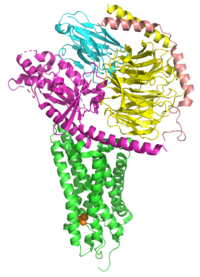
Photo from wikipedia
Odorants binding to olfactory receptor neurons (ORNs) trigger bursts of action potentials, providing the brain with its only experience of the olfactory environment. Our recordings made in vivo from locust… Click to show full abstract
Odorants binding to olfactory receptor neurons (ORNs) trigger bursts of action potentials, providing the brain with its only experience of the olfactory environment. Our recordings made in vivo from locust ORNs showed odor-elicited firing patterns comprise four distinct response motifs, each defined by a reliable temporal profile. Different odorants could elicit different response motifs from a given ORN, a property we term motif switching. Further, each motif undergoes its own form of sensory adaptation when activated by repeated plume-like odor pulses. A computational model constrained by our recordings revealed that organizing responses into multiple motifs provides substantial benefits for classifying odors and processing complex odor plumes: each motif contributes uniquely to encode the plume’s composition and structure. Multiple motifs and motif switching further improve odor classification by expanding coding dimensionality. Our model demonstrated these response features could provide benefits for olfactory navigation, including determining the distance to an odor source.
Journal Title: eLife
Year Published: 2022
Link to full text (if available)
Share on Social Media: Sign Up to like & get
recommendations!